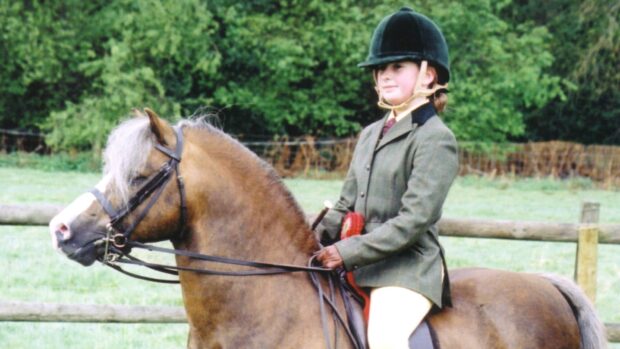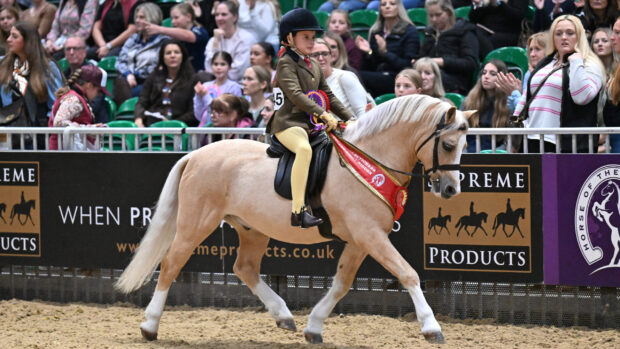The largest of the Welsh breeds, the Welsh section D — or the Welsh Cob — has no upper height limit but must exceed 13.2hh to ensure it is in fact a section D and not a section C. While there is no maximum height requirement, it is desirable that the section D retains pony character and true Welsh type.
The Welsh Pony and Cob Society (WPCS) provides the following conformation standard for both the Welsh C and the D:
General character: Strong, hardy and active, with pony character and as much substance as possible
Head: Full of quality and pony character. A coarse head and Roman nose are most objectionable
Eyes: Bold, prominent and set widely apart
Ears: Neat and well set
Neck: Lengthy and well carried. Moderately lean in the case of mares, but inclined to be cresty in the case of mature stallions
Shoulders: Strong but well laid back
Forelegs: Set square and not tied in at the elbows. Long, strong forearms. Knees well developed with an abundance of bone below them. Pasterns of proportionate slope and length. Feet well-shaped. Hooves dense. When in the rough, a moderate quantity of silky feather is not objected to but coarse, wiry hair is a definite objection.
Middlepiece: Back and loins, muscular, strong and well-coupled. Deep through the heart and well-ribbed up.
Hindquarters: Lengthy and strong. Ragged or drooping quarters are objectionable. Tail well-set on.
Hind legs: Second thighs, strong and muscular. Hocks, large, flat and clean, with points prominent, turning neither inward nor outwards. The hind legs must not be too bent and the hock not set behind a line falling from the point of the quarter to the fetlock joint. Pasterns of proportionate slope and length. Feet well-shaped. Hooves dense.
The WPCS suggest that the section D has been aptly described as: “the best ride and drive animal in the world.
“The general character is the embodiment of strength, hardiness and agility. The Welsh Cob is a good hunter and a most competent performer in all competitive sports. In recent years they have had great success in the international driving world. Their abilities in all spheres are now fully recognised throughout the world.”
Ridden Welsh Cobs classes at shows across the country usually see the biggest entries across the native breeds. They have their own final at Horse of the Year Show (HOYS) and the 2018 victory was Emma Boardman and her own gelding Dyffryngwy Sir Picasso, who was also placed third overall in the most recent BSPS Heritage native final at Olympia.
The 15-year-old stallion Llanarth Prince Of Wales was placed second in the pony section of the Cuddy in-hand final last year.
One of the biggest showcases of ridden Welsh Cobs takes place at the Royal Welsh show. The 2018 ridden cob champion was the 10-year-old stallion Northwick Notorious, ridden by Claire Evans. Stallions, mares and geldings are allocated their own sections before coming forward to compete for the overall title.
Another highly popular classes at the Royal Welsh is the in-hand cob classes. The champion takes home the coveted Prince of Wales cup. Leading the Welsh Cobs in 2018 was the Danaway Stud’s 16-year-old mare Danaway Cracklin Rose, who was taking the accolade for the second time in her in-hand career.

Danaway Cracklin Rose landed the Welsh section D championship and the Prince of Wales Cup at the 2018 Royal Welsh Show.
As with all the Welsh breeds, the section D is a popular cross. When crossed with a lighter breed such as a Thoroughbred or an Arab, depending on the quality and temperament of sire and dam, could produce a versatile performance horse suitable for any discipline.
The International Museum of Horse states that according to documentation in the 15th century, the Welsh Cob was part of the essential string of mounts for the British knight.
“A Welsh Cob or “rouncy” was used to lead the mighty fighting horses known as destriers. As the destrier’s natural gait was the trot, the Welsh Cobs had to cover great distances matching the warhorse stride-for-stride at the trot. During the crusades (1100 – 1500), the Arab stallions brought back to Wales by the Crusaders left their definitive stamp on the Welsh Cob. This blend of the Arab and native type is evidenced by the excellent Cobs of today. The Welsh Cob has made outstanding contributions to man both in war and peace. In 1485, Henry Tudor came to the throne of England only with the efforts of the Welsh Militia mounted on their swift and hardy Welsh Cobs.
“Up until 30 or 40 years ago, the Welsh Cob was so valuable to the British War Office that premiums were paid to the best stallions. The War Office used the Cobs for the mounted infantry and for pulling heavy guns and equipment through rugged, mountainous terrain not easily surmounted by motorized vehicles.
“In peace, the Welsh Cob (prior to motorized vehicles) was the quickest transport for doctors and businessmen. Quite often, the sale of a Cob was dependent on how quickly he could cover a predetermined distance without laboring. This also forged the way for many of the famous old trotting matches, such as were used to test the original Morgan Horse.”
Originally in the first British stud books of 1902, the Welsh registry listed the Welsh Pony of Cob Type as section B (12.2hh to 13.2hh), and the Welsh Cob as section C (13.2hh to 14.2hh) and section D (14.2hh to 15.2hh). The upper height limit for the section D was removed in 1907. In 1931, all sections of cobs were combined and labelled “C.” In 1949, the cob sections were changed to the current standards; section C as 13.2hh and under, the section D being over 13.2hh without an upper limit.
As well as a show animal, the Welsh Cob can excel in the dressage arena — due to their powerful trot and balanced action — or over fences. They are also very popular harness ponies, not just for private driving classes but also for marathons and trials.
For all the latest equestrian news and reports, don’t miss Horse & Hound magazine, out every Thursday




